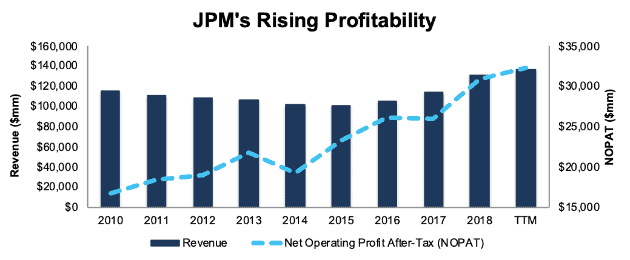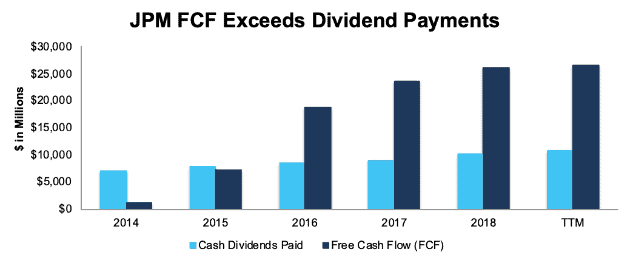Five new stocks make our Dividend Growth Stocks Model Portfolio this month, which was made available to members on June 27, 2019.
The long-term success of our model portfolio strategies highlights the value of our Robo-Analyst technology[1], which scales our forensic accounting expertise (featured in Barron’s) across thousands of stocks[2].
The methodology for this model portfolio mimics an All-Cap Blend style with a focus on dividend growth. Selected stocks earn an Attractive or Very Attractive rating, generate positive free cash flow (FCF) and economic earnings, offer a current dividend yield >1%, and have a 5+ year track record of consecutive dividend growth. This model portfolio is designed for investors who are more focused on long-term capital appreciation than current income, but still appreciate the power of dividends, especially growing dividends.
Featured Stock from June: JPMorgan Chase & Company (JPM: $112/share)
JPMorgan Chase & Company (JPM) is the featured stock from June’s Dividend Growth Stocks Model Portfolio.
Since 2010, JPM has grown revenue by 2% compounded annually and after-tax profit (NOPAT) by 8% compounded annually. Trailing twelve months (TTM) NOPAT of $32.2 billion is up 16% over the prior TTM period. JPM’s NOPAT margin improved from 15% in 2010 to 24% TTM while its return on invested capital (ROIC) improved from 7% to 11%.
Figure 1: JPM’s Revenue & NOPAT Since 2010

Sources: New Constructs, LLC and company filings
Steady Dividend Growth Supported by FCF
JPM has increased its annual dividend each of the past nine years. The company increased its annualized dividend by 14% compounded annually since 2014, from $1.58/share to $2.72/share in 2018. Its current quarterly dividend, $0.90/share, equals $3.60/share annually. Most importantly, JPM easily generates the cash flow needed to continue paying and growing its dividend. Over the past five years, JPM has generated a cumulative $76.9 billion in FCF (21% of market cap) while paying $42.4 billion in dividends.
Companies with FCF well in excess of dividend payments provide higher quality dividend growth opportunities because we know the firm generates the cash to support a higher dividend. On the other hand, the dividend of a company where FCF falls short of the dividend payment over time cannot be trusted to grow or even stay the same because of inadequate free cash flow.
Figure 2: Free Cash Flow (FCF) vs. Regular Dividend Payments

Sources: New Constructs, LLC and company filings
JPM Holds Significant Upside Potential
At its current price of $112/share, JPM has a price-to-economic book value (PEBV) ratio of 0.9. This ratio means the market expects JPM’s NOPAT to permanently decline by 10%. This expectation seems rather pessimistic for a firm that has grown NOPAT by 8% compounded annually since 2010 and 11% compounded annually over the past two decades.
If JPM can maintain 2018 margins (24%, slightly below TTM) and grow NOPAT by just 3% compounded annually for the next decade, the stock is worth $141/share today – a 26% upside. See the math behind this dynamic DCF scenario. Add in JPM’s 2.9% dividend yield and history of dividend growth, and it’s clear why this stock is in June’s Dividend Growth Stocks Model Portfolio.
Critical Details Found in Financial Filings by Our Robo-Analyst Technology
As investors focus more on fundamental research, research automation technology is needed to analyze all the critical financial details in financial filings. Below are specifics on the adjustments we make based on Robo-Analyst findings in JPMorgan Chase & Company’s 2018 10-K:
Income Statement: we made $6 billion of adjustments with a net effect of removing $218 million in non-operating expense (<1% of revenue). See all adjustments made to JPM’s income statement here.
Balance Sheet: we made $56.4 billion of adjustments to calculate invested capital with a net increase of $38.9 billion. The most notable adjustment was $16.1 billion (6% of reported net assets) related to goodwill. See all adjustments to JPM’s balance sheet here.
Valuation: we made $19.5 billion of adjustments with a net effect of decreasing shareholder value by $10.4 billion. The largest adjustment to shareholder value was $8.7 billion in off-balance sheet operating leases. This lease adjustment represents 2% of JPM’s market value. See all adjustments to JPM’s valuation here. Despite these subtractions from shareholder value, JPM remains undervalued.
This article originally published on July 3, 2019.
Disclosure: David Trainer, Kyle Guske II, and Sam McBride receive no compensation to write about any specific stock, style, or theme.
Follow us on Twitter, Facebook, LinkedIn, and StockTwits for real-time alerts on all our research.
[1] Harvard Business School features the powerful impact of our research automation technology in the case New Constructs: Disrupting Fundamental Analysis with Robo-Analysts.
[2] This paper compares our analytics on a mega cap company to other major providers. The Appendix details exactly how we stack up.
